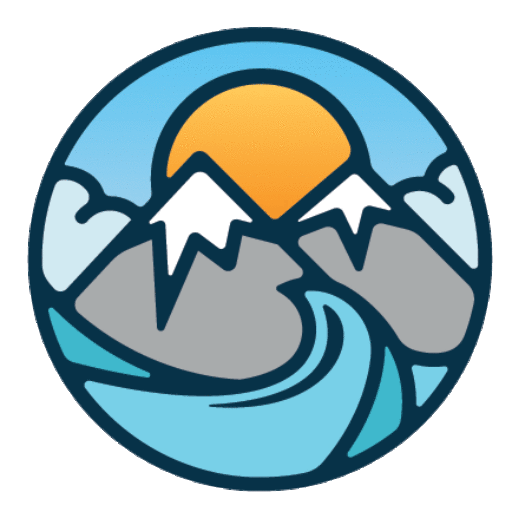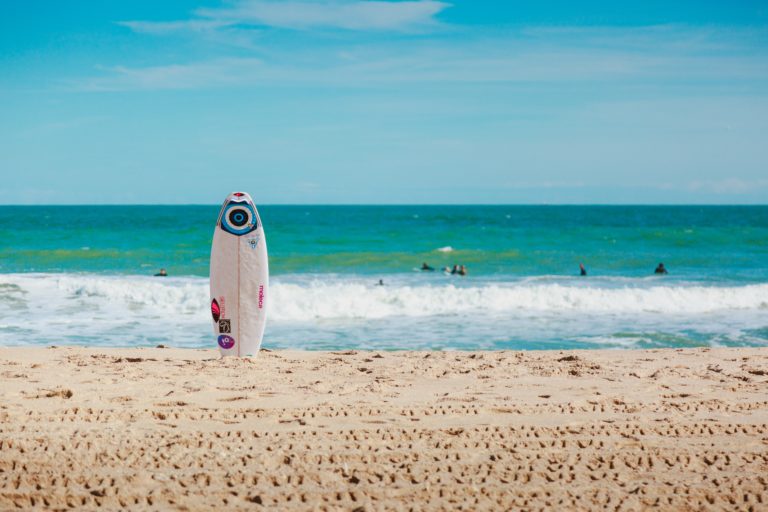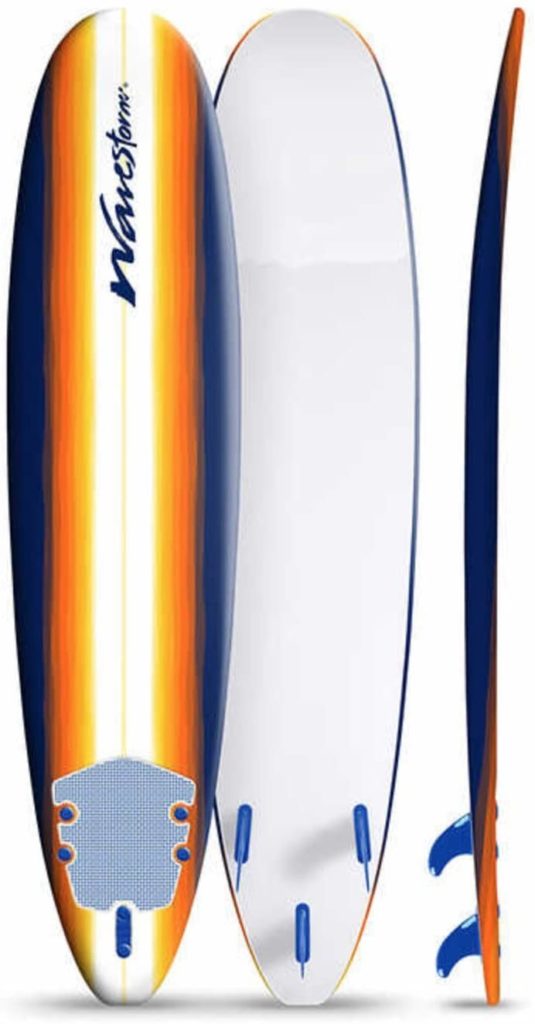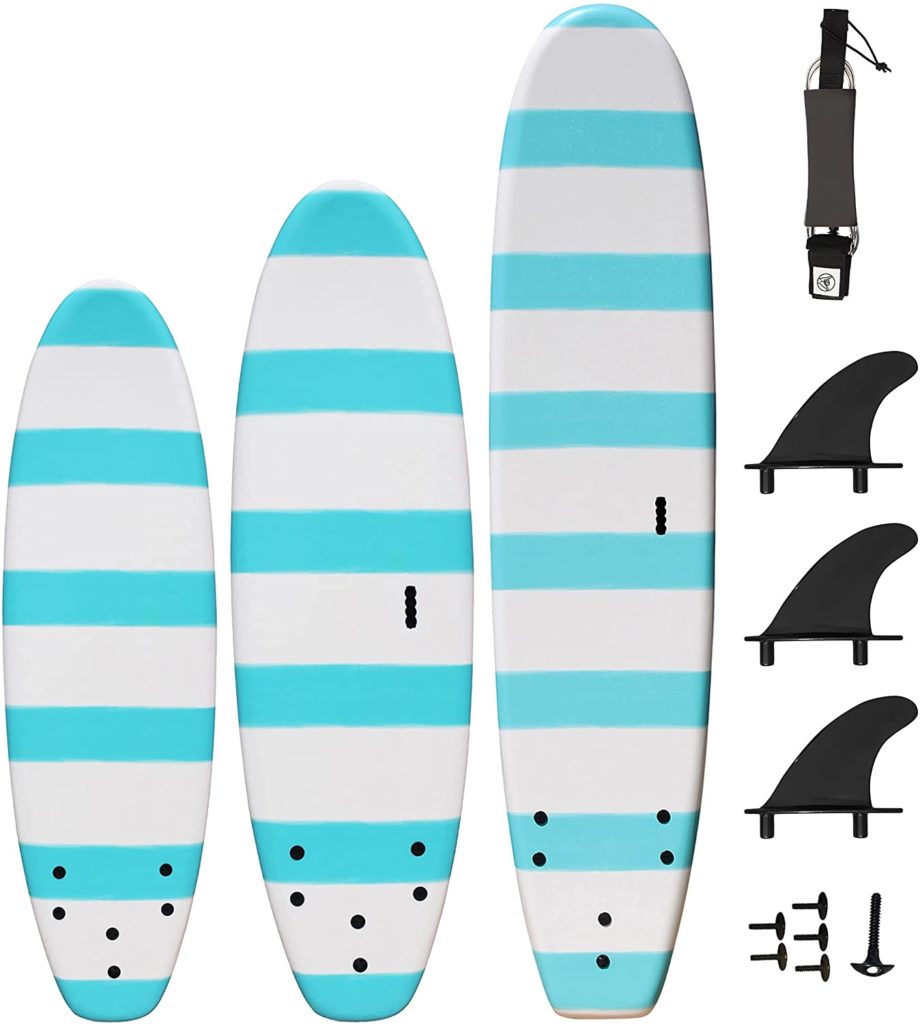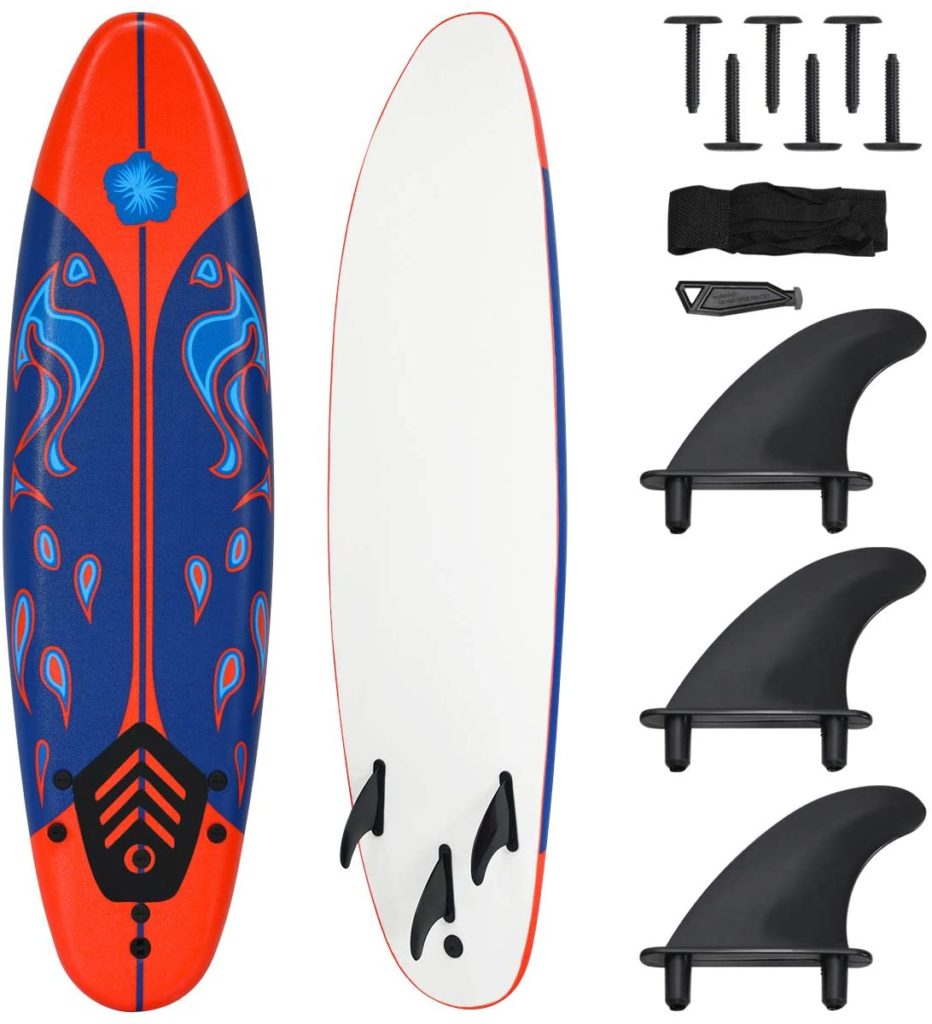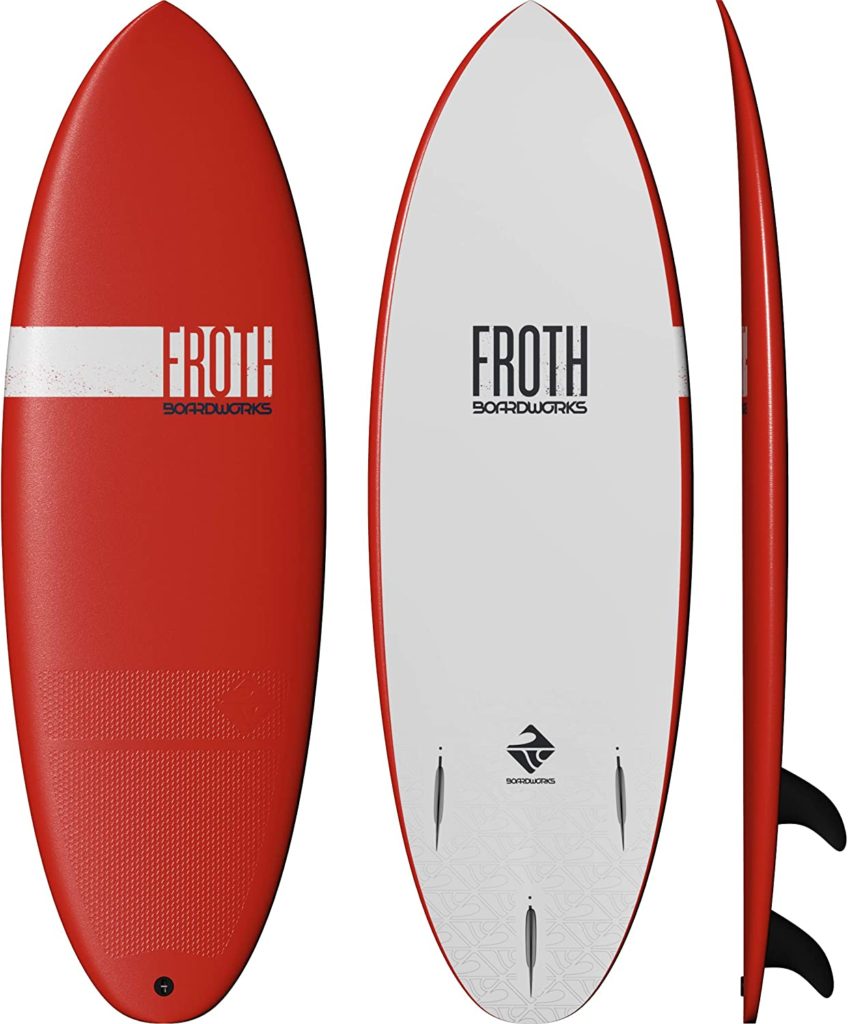A surfboard is a common object that you can find on any beach. It’s the most basic of all watercraft, and it’s also one of the best ways to enjoy the ocean. As opposed to other types of boats, a surfboard doesn’t require fuel or even electricity to work, because it relies on something much more powerful: waves! Surfing is an ancient sport that has been around for centuries and everyone from children to adults can participate in this activity. But what kind of board should you use? This article will discuss 5 boards that are perfect for beginners who want to start surfing today!
Table of Contents
Quick Overview
Wavestorm 8′ Surfboard
The Wavestorm 8’ classic surfboard is light, soft, and easy to handle and will be the perfect board for you when you want to learn how to surf! Catch that first wave and ride it out with this beginner-friendly variation of a classic shape. This board excels in stability, versatility, durability, AND fun!
Length: 8ft (243.8cm)
Width: 22.5in (57.4 cm)
Thickness: 3.25in (8.3 cm)
Guppy 5′ Surfboard
The 5′ guppy foam surfboard is a great option for beginners or anyone looking for an easy to use and durable board. The soft, but buoyant core helps with stability when you’re paddling out and the durability of this board makes it perfect to take with you on your next adventure!
Length: 5ft (152.4cm)
Width: 21in (53.3 cm)
Thickness: 3in (7.6 cm)
Gaintex 6′ Surfboard
The Gaintex Surfboard is great for beginner surfers! With a design that allows you to control speed and direction, the Giantex works best in varied wave conditions. It also has a durable design so you can use it for many years without worry or complication. And with a leash scientifically designed for safety around your body, you’ll be protected from being pulled under when surfing out on deeper waves. These features make this board the perfect choice of boards to get someone started into an amazing hobby of surfing!
Length: 6ft (182.88)
Width: 20in (50.8 cm)
Thickness: 3in (7.62 cm)
Boardworks Froth 8′ Surfboard
This large-sized board is a great option for a first-timer because there’s plenty of room to grow both physically & with more experience surfing: It’s not too bulky but still offers stability with an ergonomic shape that disrupts less water than thinner boards.
Length: 8ft (243.8cm)
Width: 23in (58.4 cm)
Thickness: 3.37in (8.57 cm)
EZ-Slider 7′ Surfboard
EZ Slider is an affordable board that is perfect for any beginner surfer! This board features a tapered nose, flat tails, through-hull fin screw holes, and all the attachments. The Foam Surfboards Shred-Core high-density EPS blank makes this board durable and lightweight so you can get up on the waves without feeling bogged down by your cumbersome surfboard. It also has 2 epoxy coated marine grade hardwood laminate stringers which make it even more firm so you don’t have to worry about getting thrown off your wave because of sudden disruptions in motion.
Length: 7ft (213.3cm)
Width: 21.5in (54.6 cm)
Thickness: 3in (7.6 cm)
What are surfboards
A surfboard serves as the main source of transportation on the waves. It helps you move from one wave to another and you can either stand up on it or kneel down on it to make turns. Surfboards, in general, are long planks that have a pair of fins at their end. As with any other board sport, you need balance and skills to be able to use your surfboard and master your craft.
Why you should buy your own surf boards
Buying your own surfboards is actually beneficial to beginners who are looking for the best surfing experience. When you’re renting a board, you have no idea how often it’s been used before or what kind of shape it’s in. You could be using a previously cracked board that could break and injure you at any point if all the pieces aren’t well secured together. Having your own board means not having to worry about those things! Future boards are also less likely to get stolen compared to rented ones because they can be kept securely in your home when not in use. Some people even customize their boards with decorations so that everyone knows that they are indeed theirs!
Tips for buying a surfboard
Shopping for a surfboard can sometimes be a bit hard to arrange. What I’ve learned from many seasons surfing can get you some advice on the right board. Shopping for the right surfboard can be really hard. When you want to buy your own surfboard, there are some things to consider before making a purchase.
Your height and weight will determine which board you should use because the size of your body is also what determines how stable you can be when standing on the board while paddling out. The shape of your surfboard also matters as it will affect how fast or slow you can move across great distances of water.
There’s certainly no right or wrong type when it comes to shapes, but beginners should always start with something relatively small for their first time surfing to make sure that they won’t get overwhelmed by the sheer amount of power being sent through the waves.
The best types of beginner surfboards
Beginner surfers aren’t all the same. The best beginner surfboard really depends on your individual needs, likes and dislikes. Before deciding which board to use, you need to consider certain factors that will affect which kind is best suited for you.
Board length: Surfboards can measure anywhere from 5’9″ (shortboards) up to 10’6″ (longboards). The height and weight of beginner surfers should be a deciding factor when choosing between these two types because shortboards are easier to balance on. If you weigh less than 130 pounds, it would be best if you choose a shorter board. Also, heavier people are more comfortable with longer boards.
Experience level: How experienced are you as a surfer? If you’re a beginner, it would be best if you choose a surfboard that’s more stable and has an even rocker. Beginners should use shorter boards since they allow the user to have better control over their movements on the waves.
The kind of wave you want to ride: Different waves require different types of boards because some are fast-paced while others move slowly. These factors will affect which right board is best for your needs. When choosing between shortboards or longboards, consider if you want to tackle smaller waves or larger ones. Shortboards are recommended when riding smaller peaks while longboards give beginners more speed and more stability in the water.
Your weight: Surfboards are made to handle people of all weights. However, the heavier you are, the more likely it is that your board will sink under your weight while out on the waves. The best way to prevent this from happening is by opting for a thicker foam board or going for an inflatable model instead.
Type of surfboards
There are several types of surfboards that you can choose from. The best beginner surfboard for you will depend on your needs, goals, and individual preferences. You can pick polyurethane foam boards, which are soft compared to the hard fiberglass or balsa wood boards.
Foam surfboards are ideal for beginners who want movement in their boards as well as superior buoyancy and they are also affordable, comfortable to use, and give you quick acceleration.
Plastic boards are another option that’s great for beginners because they don’t require any maintenance. They’re durable and lightweight, too! It can withstand long-term exposure to the sun and water without having any problems whatsoever. Also, it has a uniform surface that won’t wear down when you apply pressure on it at different points in time.
Fiberglass surfboard are also a popular choice because they’re strong enough to support heavier riders while still being lightweight enough for lighter surfers. Fiberglass is less prone to chipping compared to polyurethane foam, but these two materials are similar in many ways such as the fact that they’re made to last long and they don’t easily crack or break.
Epoxy boards, on the other hand, are heavier but more durable than foam and plastic. They also have a harder surface, making them suitable for beginners who want to learn how to perform tricks such as aerial maneuvers or advanced turns.
What are soft top surfboards
Soft top surfboards are an excellent choice for beginners because they’re usually more affordable compared to traditional boards. They have a soft foam layer and a hard plastic exterior, which makes them resistant to impact but lighter and easier to carry.
Longboard vs Shortboards
Longboards are the best surfboards for beginners because they’re stable and easy to maneuver. They usually measure over 6’6″ (like 7′ or 8′) long and are much thicker than shortboards. This makes them better in rough waters because they can absorb some of the impacts from catch waves and keep you from getting hurt while riding them. However, if you don’t feel comfortable yet with standing up on a longer board, then a shorter version could be more suitable for your primary needs as a beginner surfer.
Shortboards are usually 4’11” to 5’9″ long and their design allows users to easily perform tricks, such as carving turns across the wave face in order to catch it or doing aerial maneuvers. What’s more? They are lightweight, easy to carry around, and have precise turning capabilities, which makes them ideal for novices who want to get ahead as many waves as quickly as possible!
Pro surfer tips for beginner surfers
Scaling down the size of your board: If you have been using a soft top surfboard, then it’s time to change your equipment and start looking into shorter versions such as shortboards. By changing to a shorter board, you will gain more speed and better maneuverability in the water.
Sending them straight: You can pull off some really nice tricks by sending your boards through the wave face when they’re heading for shore or simply right after they break. You should try performing this move if you want to take big waves but have no problem with getting back to dry land afterward!
Using a bigger board at home: Many beginners often resort to using larger versions of their primary boards just so they can practice on them while they’re in their homes. What’s more? They end up learning how to perform advanced maneuvers such as aerial tricks and advanced turns, which would have been much harder with the smaller boards.
Using fins: If you are using round-tipped fins, try switching to square or diamond ones that will allow you to generate and control speed during a ride. Also, you should know that most beginner surfers use rounded tips but the best way is to get used to all types of fin shapes and sizes until you learn which one works best for your surfing style!
Practicing vertical drops: This type of move can help improve your overall scoring capacity because it helps build power into your wave catching while also being one of the best ways to take off on a wave. To perform this trick, start by holding your surfboard over your head while paddling out through shallow waves. Once you reach a larger wave, duck dive under it and make sure that you don’t go too deep!
Getting used to catching waves: Some beginners get discouraged when they find out how difficult it is to catch the right kind of waves during a first try. The most important thing is to stay calm and relaxed so that you can figure things out at your own pace! Don’t give up on surfing just because you didn’t read about or understand everything in one go; whenever something doesn’t seem like fun anymore then change it up and
How to choose the right size of board for your height and weight
Getting the right size of surfboard is very important for any surfer, beginner or not. Depending on your height and weight, you can choose either a shortboard or longboard that will be much easier to handle in the riding conditions you’re planning on riding in.
A good rule to follow when choosing a board is that: if you are shorter than 5’4″ (total height), then a board with an overall foot length from 6′ to 7′ is recommended; if you are between 5’4″ and 6’5″, then go with boards that are 7′ to 8′; and if you’re tall enough at over 6 feet, try starting out with 9-footers and then go up with sizes as you feel more comfortable!
What’s more, any beginner surfer should know that surfboards get really heavy while they have water in them. However, if you squeeze out the excess water and lay the board flat on a surface before leaning it against something like a wall or fence post, it will dry faster. Just make sure to tilt the ends of the boards upward and leave them this way overnight so that all the trapped air can escape!
Beginners should try out soft-tops: These days, most beginners prefer using soft tops because they are lighter than hard ones that weigh 60 pounds or more. As soon as you master how to handle your board on waves, try getting into small steep waves so that you can get a feel for riding soft tops!
Surfing career suggestions
Surfing can be a really fun hobby to have, but you may feel like using your skills for something else, such as becoming a professional surfer. It’s really cool to see your favorite surfers make a career out of surfing and performing in national competitions. But keep in mind that it takes years of hard work to get where you want to be, so if you want to start a professional surfing career then you will need a lot of dedication and patience! It can be extremely difficult for beginners who have little experience or who are just passionate about the sport.
The Bottom Line
The best beginner surfboards are designed to suit your needs and budget. Whether you’re looking for a soft top or want to go ahead with purchasing an expensive high-performance board, there is something for every skill level of a surfer in this article! Be sure to check out our FAQ section at the bottom if you have any questions that need answering about finding the right size of board or fin type. If you don’t find what you’re looking for here, just reach out so we can help answer any queries before they become too big of a problem. We look forward to hearing from all beginners who might be interested in surfing!
Beginner Surfboard FAQs
Which surfboard is best for beginners?
By far and away, the perfect board to start on is a soft top. Soft tops are beginner-friendly in that they are not extremely fast and do not outrun a beginner surfer. They will slow you down if you go too fast while also helping you feel more comfortable with initial turns and lineups. Soft tops don’t allow for as much freedom of movement as hard top board does but they can easily handle small waves or bigger ones when conditions are right; just be sure that your waves aren’t picking up too many shallow spots before heading out into them!
What size surfboard should a beginner get?
This depends on your personal style and what kind of surf you want to do. Beginners should start out with a small board that is between 6’6″ to 7’2″ in length and then work upwards from there as their skills improve on the waves. It’s important for beginner’s not to buy too large of a board because it will be harder for them to get up on, control, or even ride if the waves are choppy or big; it’s best to find something that has some stability but enough flexibility so you can maneuver around comfortably!
What shape board should I use?
There are many shapes of boards available for beginners, and they all suit different surf styles. For example, you may want to choose a short board if you’re interested in doing tail slides or quicker turns while paddling; a longer board will be better suited for beginner’s learning to do aerial tricks since it can stay in the air longer than its shorter counterparts! The most common shapes include longboards, funboards, mini-mal boards, fish boards, and grommets.
What fin-type should I use?
Most people start with round fins because these are the easiest type of fin to adjust to when starting out on your first board. Once you gain some experience under your belt (and get more comfortable around larger waves beginner’s guide to surfing can help you break into the sport of surfing by providing you with loads of important information such as what gear you need, how to choose a surfboard for beginners, and useful tips that other rookies have picked up throughout their time in this great sport!
How much is a surfboard for a beginner?
Surfboards for beginners can range from $30 to $250; the price usually depends on what kind of board you want. If you’re looking for a soft top or beginner-friendly model, then the prices will be cheaper than if you plan on buying a high-performance hardtop skateboard. Using your best surfboard depends greatly on how often you go surfing and where you surf at. It should not cost more than the other expensive sports equipment such as bikes or ski lessons. You can make this sport cheap by yourself without hiring an expert to teach you. This article is just to guide beginners and suggest them great boards to start off with so they can arrange their budget easily!
